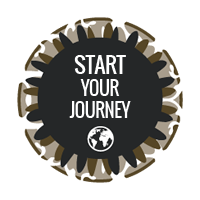The T’24 International Adventure in Peru features a 11 day / 10 night itinerary which is centered around the heart of the Sacred Valley in the Peruvian Andes. You will spend time in the vibrant city of Cuzco; you will have an opportunity live and work amongst the Huilloc community in a short homestay program; and you will undertake the Salkantay Trek into Machu Picchu – truly one of the most spectacular and mysterious ancient ruins on Earth. Tuck Partners are welcome to join!
Daily Itinerary
July 18
Details for Today
Welcome to Cuzco, Peru
Cuzco:
- Enjoy a private-guided tour of the city
- Indulge in a welcome dinner with your fellow classmates
Accommodation: Hotel Plaza De Armas
Meals: D
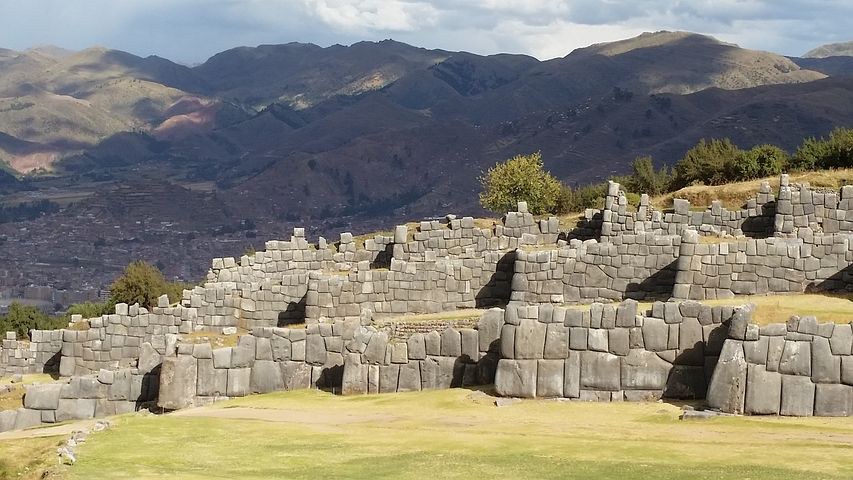
Arrive in Cuzco in the morning. You will be met at the airport and will have a private guided transfer to your hotel. In the afternoon you will embark on a private-guided tour of Cuzco.
The tour starts at Sacsayhuaman, one of the most emblematic constructions of the Incas (located just minutes from the city, it is a World Cultural Heritage Site listed by UNESCO) built by Pachacutec in the 15th century. It is a huge fortress made of large stones, of which the transportation is still a mystery.
Return to the city to continue your tour in the San Blas neighborhood, originally inhabited by the Inca nobility who built impressive stone constructions within walking distance of the Plaza de Armas (the main square). Unmistakable Inca walls can still be seen at the base of many buildings. Today the neighborhood is a delightful cluster of cobblestone streets popular among artisans who sell their handcrafts on the street.
Continue to the cathedral. This is the most impressive monument in the Plaza de Armas. Its construction began in 1560 and ended only in 1654. It took nearly a century to complete – Hundreds of stones were extracted and transported from the fortress of Sacsayhuaman under the command of the Ecclesiastical Council and the burden of thousands of Indians. The tour ends at the Coricancha also known as “The Temple of the Sun”(or Quri Kancha ‘Golden Temple’). It was built by Inca Pachacutec (1438- 1572) becoming the base of the Santo Domingo Convent upon the arrival of the Spaniards. At the Coricancha homage was payed to the Sun (“Inti”) during the Inca Empire, a time when the whole building was covered with gold.
Following the tour, you will return to your hotel in Cuzco.
Freshen up, and then transfer to Inka Grill Restaurant for your welcome dinner!
July 19
Details for Today
Transfer from Cuzco to Sacred Valley
Sacred Valley:
- Explore two of the more impressive archeological complexes in the area – Pisac, and Ollantaytambo
Accommodation: El hotel La Casona de Yucay
Meals: B, L, D
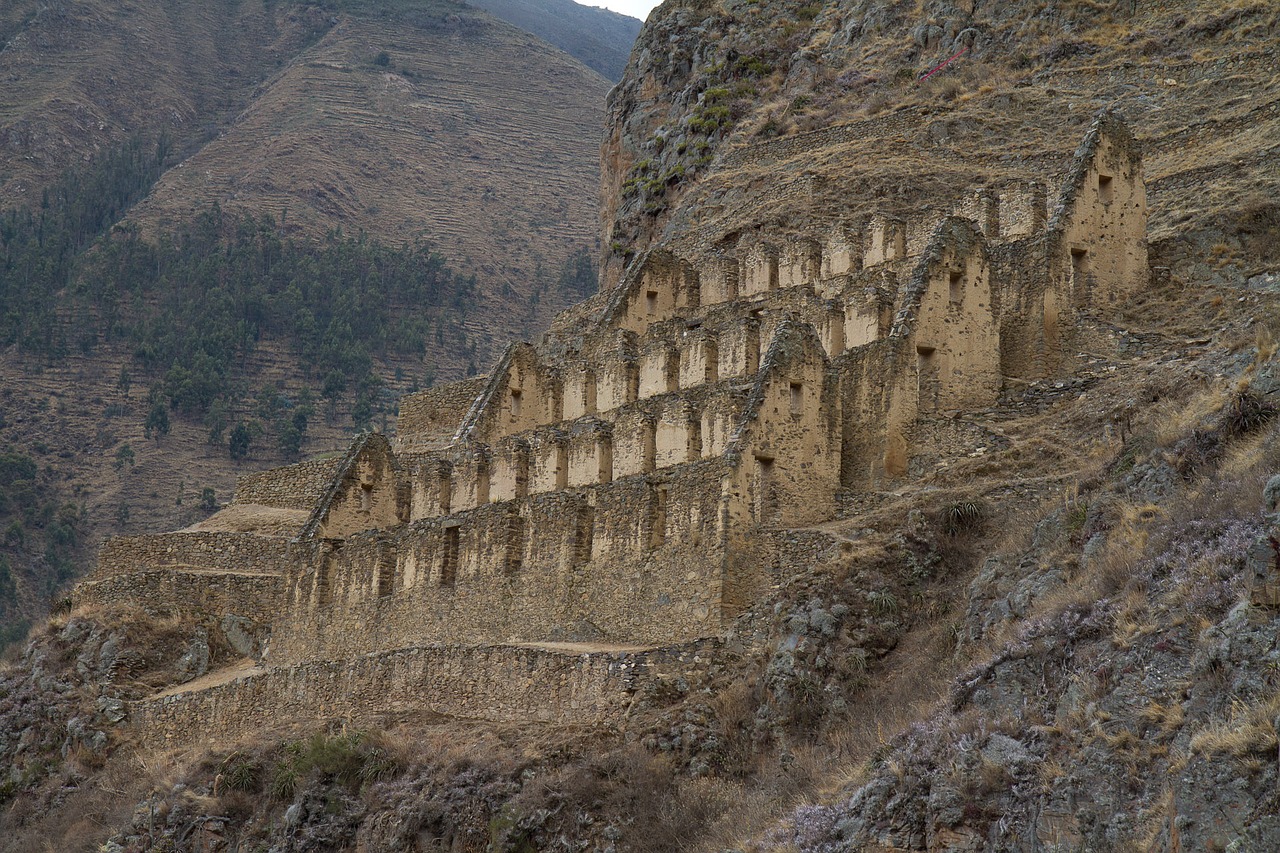
After breakfast, you will depart Cuzco and head to the nearby Sacred Valley of the Incas. Today you will explore two of the more impressive archeological complexes in the area – Pisac, and Ollantaytambo.
First we will visit Pisac, a town known for two reasons: the crafts market, established between colonial buildings, and for hosting one of the most impressive complexes of terraces in the valley, considered a masterpiece of agriculture of the Incan Empire. Visit the market, which consists of dozens of stalls displaying and selling products crafted by the residents of the area, and then continue to the archaeological remains, one of the most important of the Sacred Valley.
After Pisac you will have lunch at Muña Restaurant.
You will then head to Ollantayambo, which is a great example of typical Incan urban planning, and is still inhabited today. Here, you will find a great archeological complex known as the “Fortress”, which is a bit of a misnomer because the town actually operate as a center for rest and lodging for long distance travelers during the time of the Empire. It is without doubt one of the most monumental works of that era.
Transfer to your hotel to check-in and relax for the rest of the afternoon. Dinner will be hosted at the hotel in the evening.
July 20
Details for Today
Sacred Valley:
- Tour the village of Chinchero
- Learn traditional weaving techniques in a textile workshop
- Visit the archaeological sites of Moray and Maras
Accommodation: El hotel La Casona de Yucay
Meals: B, L, D

Today you will continue to explore the Sacred Valley.
You will start your tour in the village of Chinchero, which was one of the most important populations during the Inca Empire. However, it fell victim to the “extirpation of idolatries” action that replaced the traditional deities with Catholic ones in order to transform popular beliefs. In this way, important monuments and buildings completely disappeared.
Next the group will participate in a textile workshop where you will learn traditional weaving techniques from the native weavers, see the manufacturing process, and the final garment. Each garment is a unique result of methodical and meticulous work.
Lunch at Casa de Barro Restaurant.
Later, you will visit the archaeological sites of Moray and Maras. Moray archaeological remains consist of mysterious concentric circular terraces that for some investigators would be an agricultural research center. External platforms, more elevated, would be exposed to higher temperatures than the internal, and could simulate the conditions of different ecological floors in the empire. On the other hand, Maras is a surreal sight. It is close to Moray and is an impressive complex of salt exploitation. They are large salt deposits that were used to exchange it for other products with other regions of the empire.
You will enjoy dinner at your hotel.
July 21
Details for Today
Transfer from Sacred Valley to Huilloc Community
Huilloc Community:
- Your local cultural immersion experience begins today!
- You will be assigned to your family and will be given a task to help them with their domestic and community duties
- Share stories with your hosts
Accommodation: Homestay at a traditional family home in the community
Meals: B, L, D
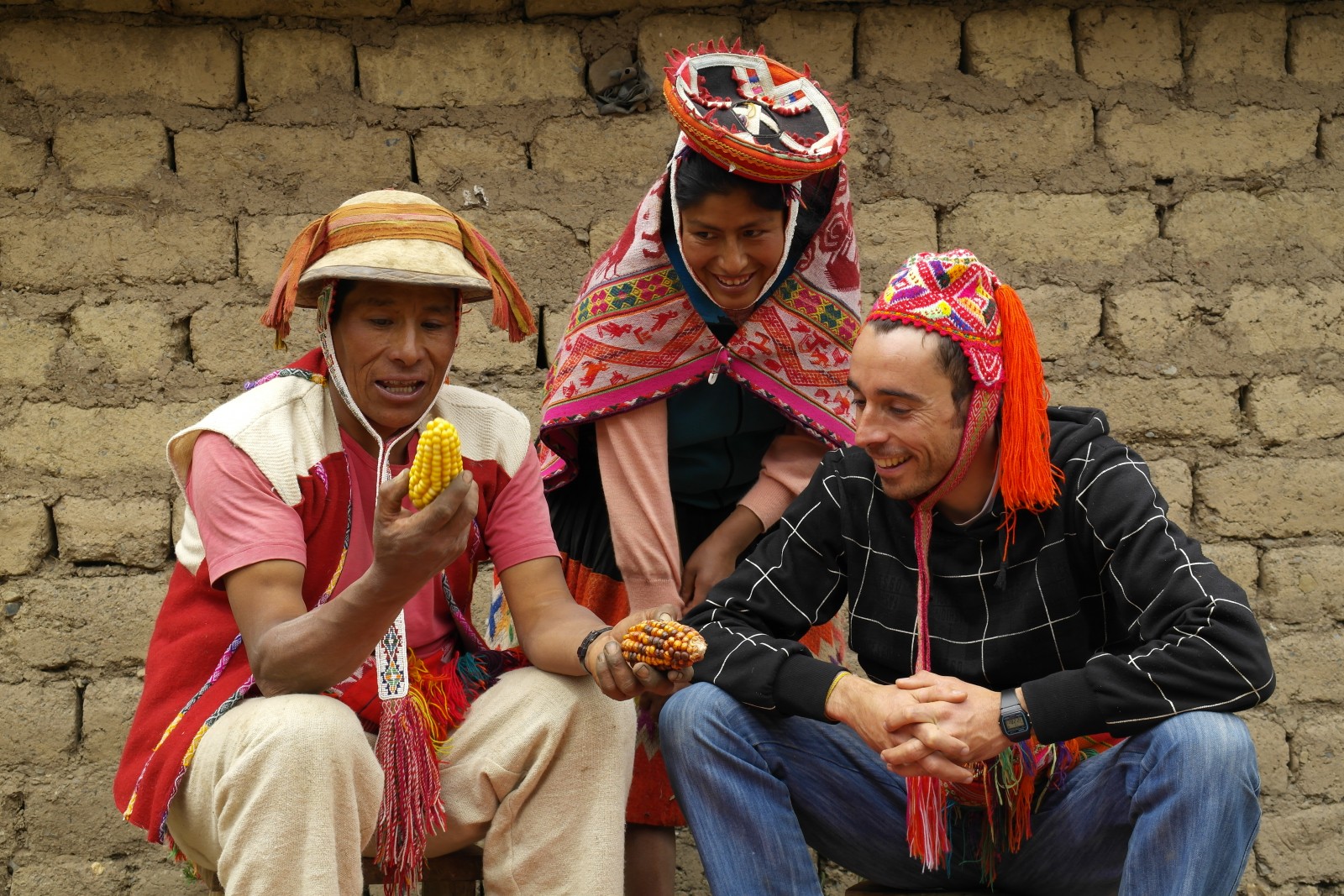
After breakfast you will be transferred to the Huilloc Community – a community co-op near Cuzco which seeks to involve international visitors with local inhabitants in an effort to help build and maintain resources for this economically challenged settlement – the average annual per capita income in this community is $232 USD per year. The Huilloc people in many ways still follow ancient Incan customs and traditions in their day-to-day lives. Visitors to the community have an opportunity to both lend an important helping hand, as well as to learn about the history and the culture of the Inca people. Visitors are assigned to local families and stay with them for the duration of their visit.
Your local cultural immersion experience begins today! You will be assigned to your a family and will be given a task to help them with their domestic and community duties. These tasks may include:
Women: Preparation and tasting of food such as chicha, papa seca, chuño, and other items of nouvelle Andean cooking.
Men: Agricultural work such as preparing the land using the chaquitaclla or plough, sowing, harvesting, post-harvest treatment and others.
During rest periods, you will have an opportunity to share stories with your hosts. You will likely learn about their costumes, how ancestors influenced on textile designs that can be seen on daily and festive attires. You may also share stories from your own countries with members of the family.
Your accommodation with the host family will be in a traditional family home in the community. You will have a comfortable, basic room, and the host family is paid to accommodate you which represents meaningful income for them. Lunch and dinner will be served in the community of Huilloc.
July 22
Details for Today
Huilloc Community:
- Participate in a larger community project of agricultural tasks and/or house building
Transfer from Huilloc Community back to Cuzco to relax at your hotel prior to embarking on the Salkantay Trek the following day!
Accommodation: Hotel Plaza De Armas
Meals: B, L, D
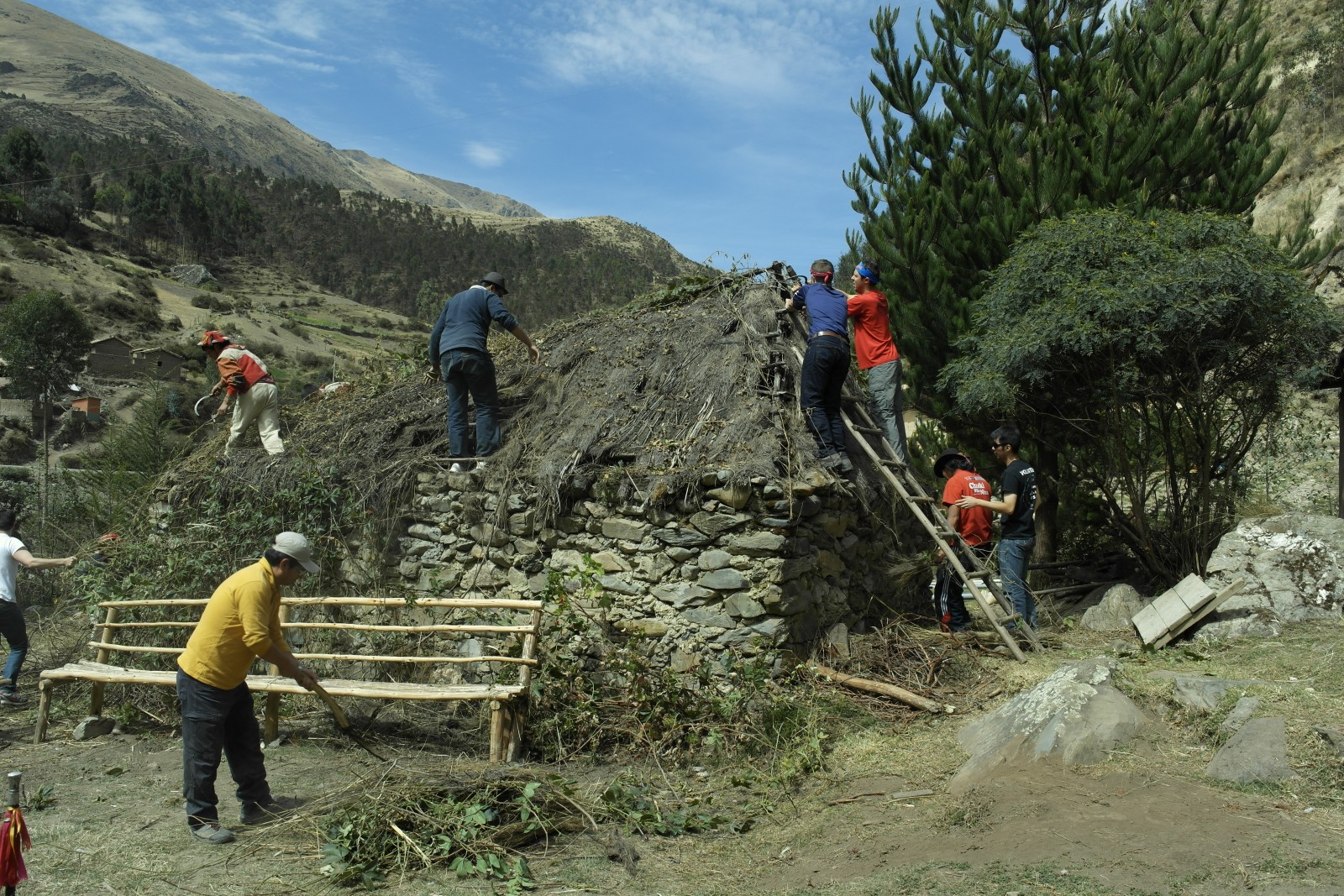
Today you will participate in a larger community project. The specific role will vary based on what is going on in the community at the time of your visit, but you will be a part of what is known as the Ayni system, a system of reciprocal labor among members of the community who share agricultural tasks and house building. This system consists of assisting with work carried out by members of a family, under the condition that they will reciprocate when necessary. This practice encourages generosity, reciprocity, and solidarity among visitors and members of the community.
Possible projects include: Painting the local school (exterior, classrooms, furniture); repairing furniture at the local school or medical post; building “Wasicuyes” for rearing guinea pigs (a staple of the diet in this region); cleaning the banks of the river or the neighborhood.
In the late afternoon you will transfer back to Cuzco to relax at your hotel prior to embarking on the Salkantay Trek the following day!
Commence Salkantay Trek — IMPORTANT NOTE
The Salkantay Trek is spectacular. It is rated as one of the top 25 hikes in the world by National Geographic Magazine, and rightly so!
That said, it is a very serious trek. You will hike 7-12 miles per day. You will reach a maximum altitude of over 15,000 feet. The trek is completed successfully by people of all ages and (within reason) fitness levels. However, you should recognize that for most people this will be a very rigorous experience.
The trek also requires appropriate attire and gear. We have provided a general outline here, and we will supply a more detailed pack-list which has been compiled by Tuckies who have traveled this route before you. Heed these recommendations, as your enjoyment of the trek will depend on it.
In the end, this trek will likely be one of the most memorable and rewarding experiences you will have – so the effort is well worth it!
July 23
Details for Today
Day 1 of your Salkantay Trek
- Start the trek at Soraypampa
- Hike to Andenes Camp
- Hiking distance: 11.25 miles
- Activity time: 8-9 hours
Accommodation: Camping at Andenes Camp
Meals: B, L, D
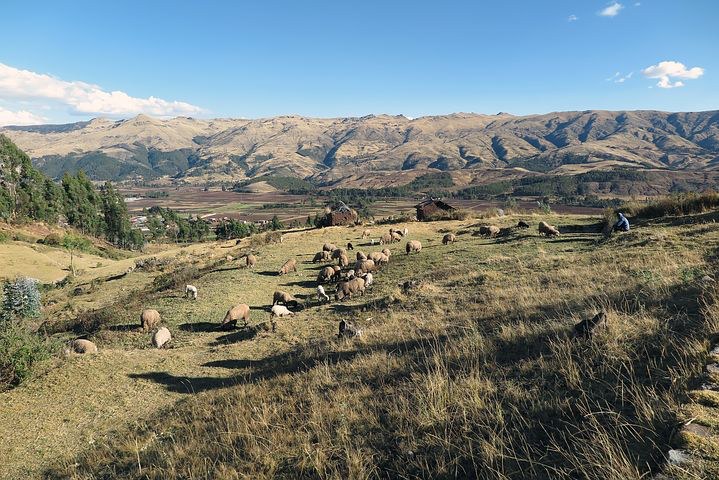
After an early breakfast, we pick you up from your hotel and leave the city of Cuzco in the morning. On the route we take a short break in the town of Mollepata before ascending a winding mountain road to Soraypampa (12,690 ft.), the starting point of the trek, where we meet our wranglers and horses. After a short introduction and a quick breakfast, we start our hike towards Salkantay Pass (15,213 ft.). At the pass we stop enjoy the views of snowcapped peaks of the Vilcabamba Mountain Range in every direction, with the glaciated south face of Salkantay towering above us where Andean condors can be seen. From the pass we descend towards Wayracmachay to enjoy our lunch and then continue descending along the left bank of the Salkantay River. Observe the landscape become increasingly green, changing from highland to jungle or cloud forest. Feel the warm air rising from the jungle, accompanied by colorful butterflies and striking orchids, while arriving to camp at Andenes (9,481 ft.), a beautiful spot surrounded with vegetation.
July 24
Details for Today
Day 2 of your Salkantay Trek
- Hike to Lucmabamba Camp
- Enjoy a coffee tasting with a local family
- Hiking distance: 11.25 miles
- Activity time: 8-9 hours
Accommodation: Camping at Lucmabamba Camp
Meals: B, L, D
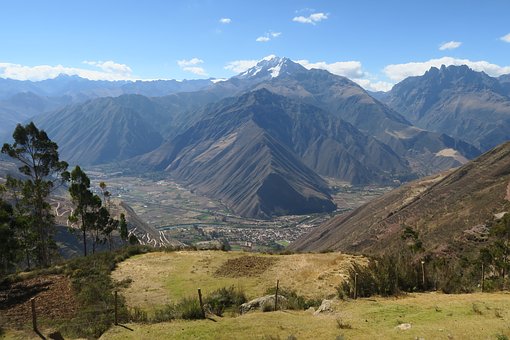
Today we hike along the Santa Teresa River Valley, through more populated rural areas. We pass through banana, granadilla, avocado and coffee fields. A hot picnic lunch will be served along the way. After lunch, we hike for about 2 hours before a private vehicle meets us for a short drive to the beginning of the next trail. From the head of the newly restored Inca trail we easily make our way to the next campsite at Lucmabamba.
In the evening the group will enjoy a coffee tasting demonstration with a local family. Enjoy your dinner by the light of the campfire.
Overnight at Lucmabamba Camp.
July 25
Details for Today
Day 3 of your Salkantay Trek
- Hike up to an exceptional view and enjoy lunch overlooking Machu Picchu
- Hiking distance: 7.5 miles
- Activity time: 5-6 hours
Transfer on a scenic train ride to Aguas Calientes
Accommodation: El Mapi Machu Picchu Hotel
Meals: B, L, D
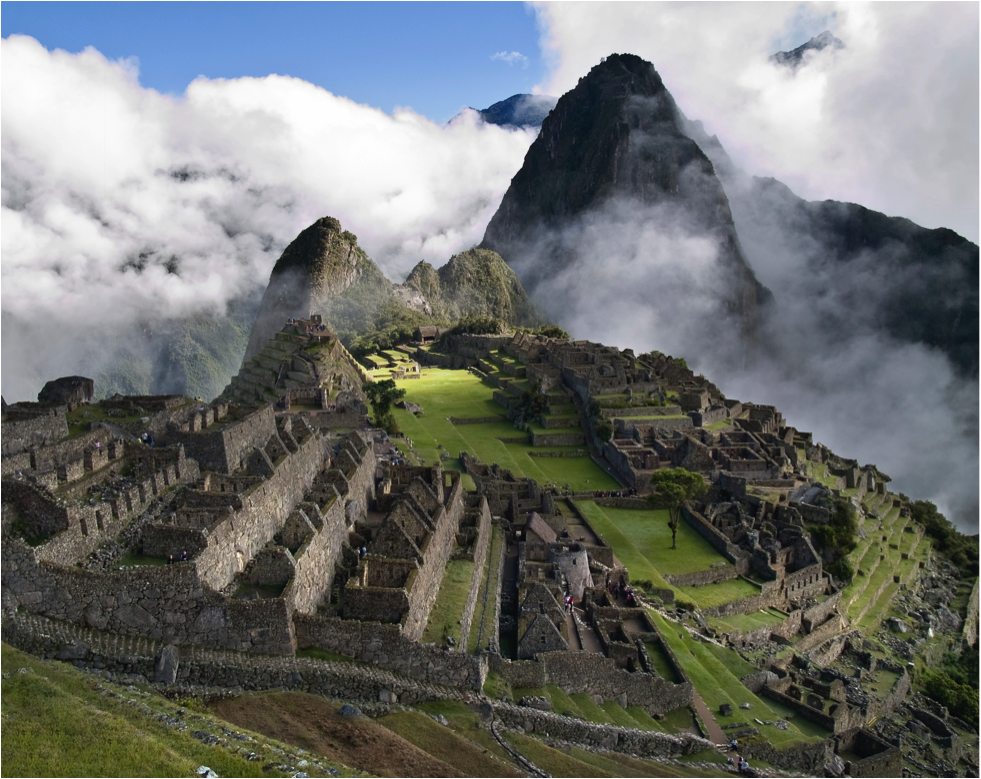
After breakfast, we will head uphill for 2-3 hours towards Llactapata Pass (8,974 ft.) and descend to the archaeological complex of the same name. From here we have an exceptional view of the Lost City of the Incas, the legendary Machu Picchu. The view is from a different angle, one that few travelers get the chance to admire. Lunch is served overlooking Machu Picchu.
After lunch, begin the final descent to the Aobamba River through lush bamboo forests, orchards and coffee plantations. Finally we will get to the Hydroelectric Power Station of Machu Picchu from where we board the train to Aguas Calientes to spend the night (short, scenic 40-minutes train ride).
Dinner and overnight at El Mapi Machu Picchu Hotel.
July 26
Details for Today
Machu Picchu:
- Private-guided tour of the Inca citadel
- Enjoy free time to explore the area
Transfer by train back to Cuzco
Accommodation: Hotel Plaza De Armas
Meals: B, L
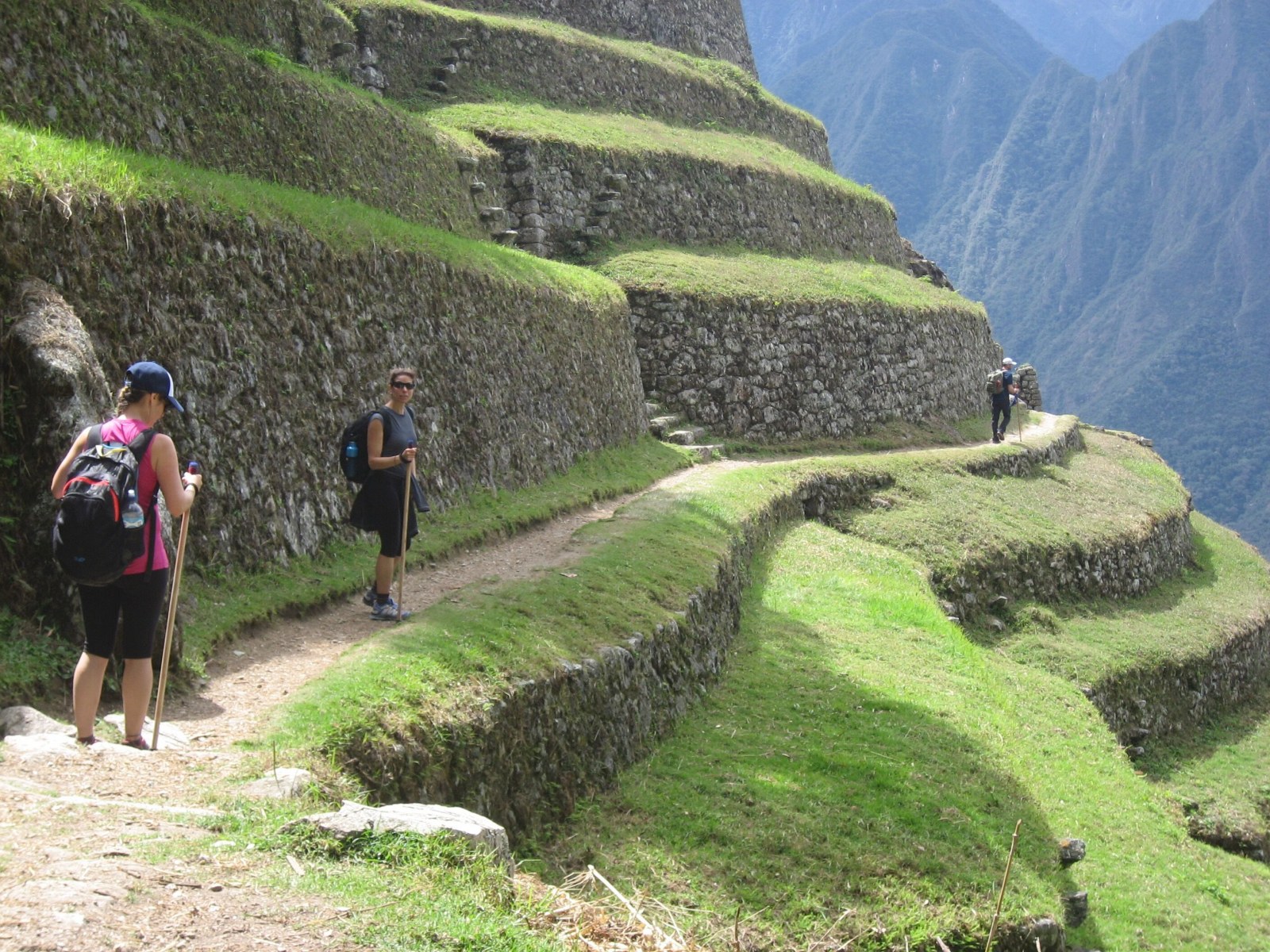
This morning we wake up early and board a bus to Machu Picchu where we begin a complete guided tour of the Inca citadel that will take approximately two hours. You will then have free time to walk around, and enjoy the spectacular views of Machu Picchu, and the valleys and mountains that surround it.
We will return by bus to Aguas Calientes for lunch at Café Inkaterra.
Then board the train to Ollantaytambo. From this point, a private vehicle will drive us back to Cusco and you will be transferred to your hotel.
You will arrive in Cusco at approximately 7 or 8 pm. You are free for dinner at leisure.
July 27
Details for Today
Cuzco:
-
Enjoy a day at leisure
- Farewell dinner
Accommodation: Hotel Plaza De Armas
Meals: B, D
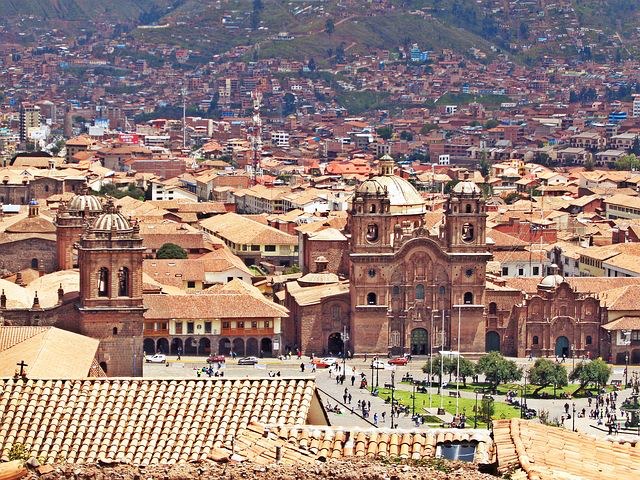
Enjoy the day to explore the city, or stay at your hotel to rest if you prefer.
In the evening you will be picked up and transferred to your farewell dinner at Incanto restaurant.
July 28
Details for Today
Depart Peru
Meals: B
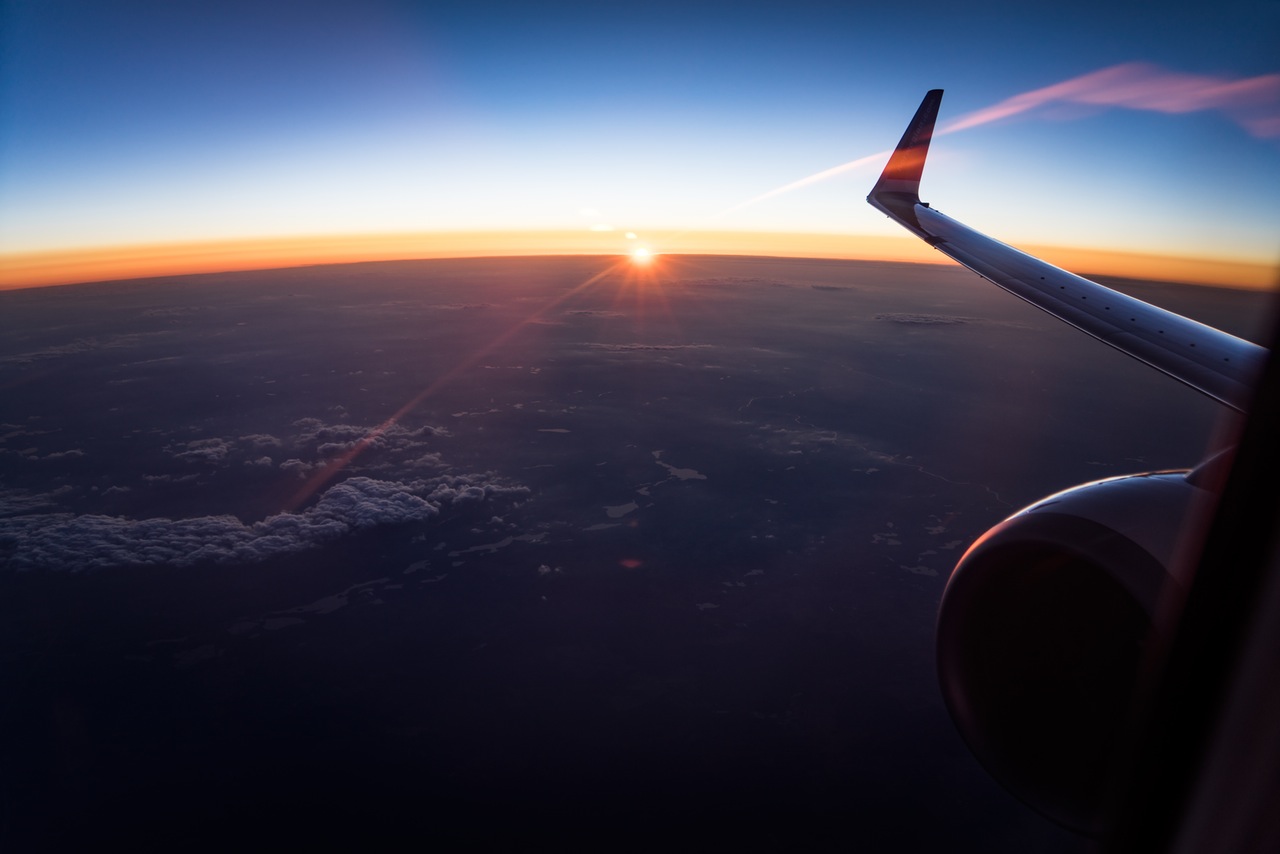
Today, we have arranged a rotation of private transfers throughout the day from the hotel to the airport to connect to your flight home.
It’s time to say goodbye. Have a pleasant journey!
Accommodation
Cuzco – Hotel Plaza de Armas
Located in the heart of Cuzco with the best panoramic view of the city, Hotel Plaza de Armas has a modern and minimalist decor that offers guests a personalized and comfortable stay. The hotel is ideal for travelers interested in food, history and culture.
See the TripAdvisor writeup here.
Sacred Valley – El hotel La Casona de Yucay
El hotel La Casona de Yucay is surrounded by snow-capped mountains, located in a picturesque town in the heart of the Sacred Valley. The Colonial House built in 1810 will transport you through time to a place where history, nature and warm service come together. You can relax and feel the magic of the Sacred Valley of the Incas surrounded by spectacular views and beautiful gardens.
See the TripAdvisor writeup here.
Aguas Calientes – El Mapi Machu Picchu Hotel
Step into the smart, contemporary and cozy confines of El MaPi, amidst the picturesque Machu Picchu Pueblo. Discover an efficient, lively and friendly atmosphere, welcoming guests expecting an unfussy, down-to-earth break. The flowing lobby creates a sense of vitality. Lofty ceilings, panoramic windows and an open café allow natural light to filter between tall eucalyptus dried branches, creating an ambience of order and wellbeing.
See the TripAdvisor writeup here.
Pricing
The cost for the Tuck International Adventure in Peru is $2,298 USD per person. Should you wish to have your own room, we can arrange this for you with an additional single supplement of $671 USD.
To book this trip, please refer to next steps.
NOTE: In light of the ongoing Covid-19 pandemic, we are maintaining flexibility to cancel this trip and return all deposits / payments if it is deemed unsafe to travel to Peru. In such a situation, this would override the payment / cancellation / refund terms outlined in the “What’s Next” section of the main trip webpage (where you will be taken when you click the “next steps” link above). We will closely monitor the situation and will provide frequent updates to trip registrants. From a pandemic perspective, this trip will be confirmed as a go or no-go as of June 15, 2022. After this date, all payments will be non-refundable. Terraficionados strongly advises that students obtain Travel Insurance to protect their investment in this trip.
Price includes:
- Private transfers from / to airport in Cuzco
- Private-guided touring throughout
- All activities outlined in the itinerary
- All lodging summarized in the itinerary
- Sleeping bags and tents on the Salkantay trek
- 10 breakfasts, 8 lunches, 9 dinners
Price excludes:
- International flights
- Personal expenses
- Domestic / international airport taxes
- Porter to carry guests luggage on trail
- Tipping
Guidance on how to budget for items not included:
The amount of expense you will incur over and above the trip price will vary based on each individual’s preferences. That said, the following should help you budget for additional amounts you may spend while in Peru:
- A typical lunch in Cuzco will cost $15-$30 USD per person (including drinks)
- A typical dinner will cost $15-$30 USD per person (including drinks)
- A local beer costs $3 USD in restaurants / bars; $6 USD in hotels and fancy restaurants; Craft beer costs $8 USD
- A glass of wine costs $12 USD in restaurants, and $18 USD in hotels
- Budget for tipping
- When you are with private guides and drivers, assume roughly $5/person/day for guide; $3/person/day for driver
- On Salkantay Trek, assume roughly $10-$20/person/day to be split across the guide and support team, but you can ask the trekking guide for some guidance here
- Here’s some general guidance on tipping in Peru
ATMs are available in Cuzco (and in most of the places you will visit). Some ATMs in Cuzco charge a transaction fee. Credit cards are also widely accepted. Once you leave Cuzco, you are unlikely to have much access to ATMs or much ability to use credit cards so plan accordingly. It is always advisable to bring $200 – $300 USD cash in case of emergency.
Before You Go
Packing Prep and Advice
Climate: When packing please keep in mind that Cusco’s climate is divided into two differentiated seasons: the rainy season, from November to April (the heaviest rainfalls occurring usually between January – March); and the dry season, from May to October. The dry season is colder, so temperatures can drop to below 0 degrees at night.
Along the Salkantay route, temperatures range from 10-20ºC during the day if it’s sunny, to 5-10ºC during the day if not sunny and can drop below freezing at night. In Aguas Calientes/Machu Picchu, at lower altitude, temperatures are usually warmer though warm clothes are still recommended at night. PLEASE NOTE – in the past the group has experienced a snow storm while on the Salkantay Trek! This is rare, but in the mountains the weather can be variable and it does get very cold at night. So make sure you have hats and waterproof gloves with you on the trip!
Appropriate clothing along this hike: Hiking pants and T-shirts are recommended during the day, complemented by sweaters, fleeces and waterproof jackets. It is very convenient to have light raingear available in the daypack (rain poncho or jacket and/or rain pants) as the weather changes easily and rains can suddenly occur. At night, warm clothing is required, down jackets can be useful, otherwise a fleece and a jacket. During the third day (if sunny) and in Machu Picchu, convertible hiking pants are useful, as can be switched into shorts if necessary. Machu Picchu has a warm climate, getting only cold at night.
What we recommend that you bring:
- A backpack with a change of clothes for the whole period of the trek (20L should be fine). Ideally get one that is made for hiking (i.e. has a belt to take weight off of shoulders)
- Rain gear (jacket and pants if available) or rain poncho (plastic ponchos can be purchased in Cusco)
- Strong footwear, waterproof trekking boots recommended
- Hiking socks (preferably wool, but synthetic is ok)
- Sandals or jogging shoes for a higher comfort while at camp
- Warm clothes, including jacket, fleeces. Thermal clothing is also recommended, especially for sleeping. Layering is going to be important
- Flashlight/headlamp and batteries
- Camera, films and batteries (batteries consume more quickly under cold conditions)
- Winter hat and sunhat to protect you from the rain, cold and sun
- Gloves for night
- Sunglasses
- Sun block for face, body and lips
- After-sun cream or hydrating cream for face and body
- Insect repellent – minimum recommended 20% DEET – no malaria risk has been reported
- Medicine for common illnesses (allergies, colds and flu, diarrhea, headaches, stomach aches)
- Band-aids – blisters happen
- Hand sanitizer/Sanitizing wipes
- Handkerchiefs
- Toilet paper
- Snacks: biscuits, energy bars, chocolate, raw fruits, muesli, etc. Please note that we do provide a daily morning snack and our meal service is very complete and well supplied. This recommendation applies for all clients being used to a specific snack, as it may happen that it is not included in our selection
- Water container and water for the first morning. Important notice: plastic water bottles are no longer allowed into Machu Picchu. Plastic water containers (i.e. Nalgene) or metal ones are recommended
- Small towel
- Swimsuit (if you wish to go to the hot springs in Aguas Calientes)
- Cash in soles and/or US$
- Original passport
- Optional: walking sticks or poles (rubber covers required in order not to damage archaeological sites)
Items provided for you in Peru (you DO NOT need to bring these items):
- Sleeping bags, liners, pillows
- Tents
- Duffel bag
Visas and Vaccinations
It is the responsibility of all travelers to ensure that proper travel documentation is in place. All countries require a valid passport (with at least 6 months’ validity). Contact your local embassy or consulate for up-to-date visa requirements. (American residents, click here for the State Department’s latest outline of travel documentation requirements).
Travelers should consult a family physician or your local travel clinic for up-to-date health information and any requirements for vaccines. More information can be obtained from the ISTM by clicking here. Or, contact your country’s Health or Foreign Affairs department.
Medical and Travel Insurance
Proof of out-of-country medical insurance is required. Terraficionados offers various Cancellation & Interruption, Lost Baggage, and Out-of-Country Medical insurance coverages for Canadian and American residents. If you need information, a quote, or to book travel insurance please click here, or you may contact another provider. International students who are not yet US residents should consult insurance providers in their home country.
Peru Overview
In Peru, Geography is master. The country is dominated by its geography and man has had to cope with it for millennia. It is a land of tropical mountains. The Andean Mountain Range is the back bone of Peru. In fact it is South America’s spinal cord and divides Peru in two; on the west lays one of the driest deserts on Earth. East of the mountain range is a place dominated by green; the Amazon. No other place on Earth receives more rainfall than these rainforests. And so Peru seems to be a Land of Contradiction; it is home of extremes. No other country has so much desert, so many mountains, and such a prolific rainforest all in one.
This mountainous setting is where civilization in the Americas was first born and where it reached its peak before the collapse of the Incas 500 years ago. The mountains are far more than a cluster of material, of rock and earth; Peruvians call their mountains Apus. This is the word for the Gods that inhabit the mountain. It is a Quechua term that implies considering the Mountain as a living organism, as Nature itself as a being. This is where the respect for the Environment in Peruvian ancestral cultures originates.
The Andes Mountains get their name from the term Antis, the Quechua word used to name those who lived in the “green desert,” that is, the tribes from the Amazonian Rainforests. The Andes are made up of several smaller ranges; Vilcanota and Vilcabamba in the south, Azul in the north and Huayhuash and Blanca right in the center of Peru.
The mysterious and spectacular ruins of Machu Picchu was discovered by Hyram Bingham’s exploration of the area in 1911. It had been lost for centuries, taken over by the dense green jungle. Over time, many of the trails leading into Machu Pichu have been restored; the Inca Trail is the most famous, but the Salkantay route is the most spectacular.

